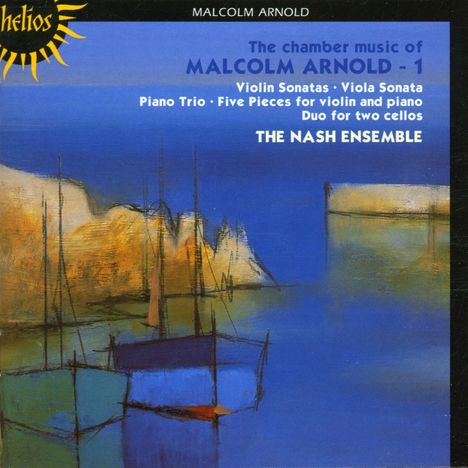Malcolm Arnold: Kammermusik Vol.1 auf CD
Kammermusik Vol.1
Herkömmliche CD, die mit allen CD-Playern und Computerlaufwerken, aber auch mit den meisten SACD- oder Multiplayern abspielbar ist.
Lassen Sie sich über unseren eCourier benachrichtigen, falls das Produkt bestellt werden kann.
Violinsonaten Nr. 1&2; 5 Stücke f. Violine & Klavier; Violasonate op. 17; Duo f. 2 Celli op. 85; Klaviertrio op. 54
Die Hauptthemen aus dem ersten Satz des Klaviertrios (1956 vom St. Cecilia Trio uraufgeführt) sind ernst und liedhaft; zunächst jedoch machen Geige und Cello mit einem rhetorischen Unisono auf sich aufmerksam, woran das Klavier drei prägnante Kommentare anhängt, die später im Satz eine bedeutende Rolle spielen werden. Im Mittelsatz folgt die Geige dem Cello im zweistimmigen Kanon. Das Klavier antwortet mit einer tröstlich sequenzierenden Phrase, und der Vorgang wiederholt sich in umgekehrter Form. Die emotionale Temperatur steigt in einem üppiger gesetzten Mittelteil und sinkt erneut, als der Kanon erneut aufgegriffen wird. Das sieben Takte lange einleitende Unisono des letzten Satzes schafft die harmonische Basis für die anschließenden elf Variationen. Nr. 3, 4 und 5 bilden eine Dreifachvariation, in der Klavier, Geige und Cello nacheinander die Sechzehntelbewegung vorantreiben; 7 und 8 sind eine kanonische Doppelvariation. Eine kurze, aber gewichtige Coda bringt das Trio schlüssig und ohne unnötiges Zeremoniell zum Abschluss.
Product-Information:
The main themes of the first movement of the Piano Trio (first performed by the St Cecilia Trio in 1956) are grave and song-like; but first, violin and cello demand attention with a rhetorical unison, the piano appending three distinct comments which are to play important roles later in the movement. In the central movement, the violin follows the cello in a two-part canon, the piano responding with a consoling sequential phrase, and the process repeats in inversion. The emotional temperature rises in a more richly scored middle section, falls again as the canon is resumed. The seven-bar opening unison of the last movement establishes the harmonic basis for the eleven variations which follow. Variations 3, 4 and 5 form a triple variation in which piano, violin and cello in turn carry forward the semiquaver movement; 7 and 8, a double canonic variation. A brief but weighty coda brings the Trio to an end conclusively and without unnecessary ceremony.
Rezensionen
'The Nash’s superb 1984 set of Malcolm Arnold’s chamber music makes a welcome return. The wide stereo spread of the quintets … enhances the sense of being in the room with the musicians’ (BBC Music Magazine)
‘An entertaining, at times compelling portrait of a British composer whose true measure we’re only just beginning to gauge' (Classic FM Magazine)
'The playing of the various members of the Nash Ensemble is impeccable, as indeed is the recording' (The Penguin Guide to Compact Discs)
'Reveals Arnold at his most inventive: tuneful, witty and ingenious … The performances by the individual members of the Nash are impeccable. This set may one day be equalled but it is unlikely to be bettered, and it deserves classic status' (International Record Review)
'An entertaining, at times compelling, portrait' (Classic FM Magazine, 'Best Buy’)
Disk 1 von 1 (CD)
-
1 Violinsonate Nr. 2 op. 43 (1953)
Fünf Stücke für Viioline und Klavier op. 84 (1965)
-
2 Prelude
-
3 Aubade
-
4 Waltz
-
5 Ballad
-
6 Moto perpetuo
Violinsonate op. 17 (1947)
-
7 1. Andante
-
8 2. Allegretto grazioso
-
9 3. Presto feroce
Violinsonate Nr. 1 op. 15 (1947)
-
10 1. Allegretto
-
11 2. Andante tranquillo
-
12 3. Allegro vivace
-
13 Duo für zwei Celli op. 85 (1964)
Klaviertrio op. 54 (1956)
-
14 1. Allegro con fuoco
-
15 2. Andante
-
16 3. Vivace energico







